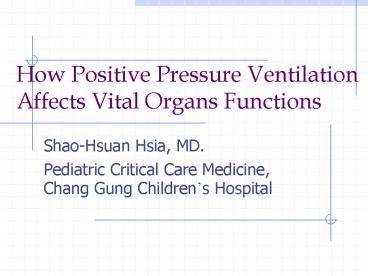How Positive Pressure Ventilation Affects Vital Organs Functions PowerPoint PPT Presentation
1 / 39
Title: How Positive Pressure Ventilation Affects Vital Organs Functions
1
How Positive Pressure Ventilation Affects Vital
Organs Functions
- Shao-Hsuan Hsia, MD.
- Pediatric Critical Care Medicine, Chang Gung
Childrens Hospital
2
Why is this topic important?
- Ones meal is another ones poison
- Respiration affects several major body
compartments thorax, abdomen, cranium, muscle
tissue spaces. - Take care of the whole body, not only one organ
system - Adverse effects of mechanical ventilation exist
- Respiratory system dysfunction is potentially a
cause of multiple organ dysfunction syndrome
(MODS)
3
How Positive Pressure Ventilation Affect Vital
Organs Functions
- Respiratory system-cardiovascular system
- Respiration as exercise
- Increased lung volume
- Intrathoracic pressure
- Respiratory acidosis/alkalosis, inhalation gases
- Respiratory system-vital organs
- Brain
- Liver
- Kidney
- Oxygen toxicity
4
DO2CO?(1.34?Hb?SaO20.003PaO2)
5
Increased Lung Volume
- Vtlt12ml/kg vagal withdrawal?tachycardia
- Vtgt15ml/kg sympathetic withdrawal? bradycardia
- Humoral factors cyclo-oxygenase inhibition, NO
- Mechanical compression of LV
- Pulmonary vascular resistance
- Ventricular interdependence
6
Pulmonary Vascular Resistence
7
Ventricular interdependence
Positive pressure ventilation can restrict RV
volume and decrease ventricular interdependence
effects Ventricular interdependence can be
worsened by pulmonary hypertension
8
Intrathoracic Pressure
- Venous return
- RV preload and afterload
- LV preload and afterload
- Pulmonary resistence
9
Systemic Venous Return(RV Preload)
Volume expansion shifts the line to right
PPV increases RAP
RAP
Spontaneous Breathing
Max
0
Systemic Venous Return
10
???????
Vena Cava
???????
???????
RA
RV
PA
??? ????
11
???????
Thoracic pump augmentation
???????
???????
Lung
Lung
LA
LV
Ao
12
???????
13
??????????
Effect of HFJV on PAH
(n13)
Plt0.01 vs. HFJV
Meliones Circ 1991
14
???????????
Effect of pH on PVR
Plt0.01 vs hypoxia
PVR
Lyrene RK 1985
15
??????????
16
??????????
NO for PAH post OP for CHD
PAP (mmHg)
SaO2
Journois J T CVS 1994
17
How Positive Pressure Ventilation Affect Vital
Organs Functions
- Respiratory system-cardiovascular system
- Increased lung volume
- Intrathoracic pressure
- Respiratory acidosis/alkalosis, inhalation gases
- Respiratory system-vital organs
- Brain
- Liver
- Kidney
- Oxygen toxicity
18
??????
CBF vs. Glasgow outcome score 3 months post
injury Robertson et al. 1992
of Patients
CBF Groups
19
Positive Pressure Ventilation and Cerebral
Perfusion
- Cerebral perfusion pressuremean arterial
pressure?intracranial pressure - CPPMAP ?ICP (CVP when CVPgtICP)
- PEEP ?ITP, ?VR, ?CVP
- Normal ICP PEEPgt10cmH2O ? ICP
- Increased ICP PEEPltICP is safe
- McGuire et al 1997
- PaCO2
20
PEEP vs. normal ICP
plt0.05
21
PEEP vs. elevated ICP
22
?????????
Volume change(ml/100ml brain)
Palmer, Acta Paediatr 1995
23
Impaired Pressure-Flow Autoregulation
Maximal Normal
Maximal Vasodilation Autoregulation
Vasoconstriction
Unexpected Hypermia
Unexpected Ischemia
CBF
Normal Autoregulation Disrupted
Autoregulation Partial Disrupted Autoreg
0 25 50 75 100 125 150
CPP (mmHg)
24
???????????-TCD
Hyperventilation ? Vasoconstriction (Ischemia) ?
ICP but ? PI
ICP
Pulsatility Index (PI)
40 35 30 25 PaCO2
25
????CMRO2???
6.0
- hypo-
- perfusion
AVDO2(?mol/ml)
4.0
ischemia
CMRO2
normal
1.8
1.5
2.0
hyperemia
1.2
infarction
0.9
0.6
0.3
0
0
0.4
0.8
1.2
CBF(ml/gm/min)
Robertson J of Neurosurg 1989
26
Positive Pressure Ventilation and Liver Function
- Patients with sepsis, trauma and ARDS usually
combine liver dysfunctionendotoxin, shock,
hypoxemia and DIC - ?CO? ?hepatic artery and portal vein blood flow
- ?ITP??hepatic vein pressure (Phv)??hepatic flow
- Descending diaphragm compression? ?intrahepatic
closing pressure (Pc)? ?sinusoidal cell-blood
contact time - ?Peak-inspiratory RAP? ?hepatic blood flow
pressure gradient - ?abdominal pressure? ?Ppv, and ?Pc
27
Hepatic blood flow interactions
Qha
Pha
Diaphragm
QL
Qvc
Rha
Phv
Ps
Pc
Pra
Rpv
Pab
Ppv
Qpv
Matushak et al J Crit Care 1989
28
Plt0.001
N6
plt0.05
Matuschak et al. J Appl Physiol 1987
29
Positive Pressure Ventilation and Renal Functions
- PPV may decrease CO and MAP
- The partial occlusion of IVC increase renal vein
pressure (RVP) and retention of Na and water - Sympathetic nervous system/renin-angiotensin-aldos
terone system/atrial natriuretic factor (ANF)
system.
30
Positive Pressure Ventilation and Renal Functions
- ?venous return?deactivate low pressure
baroreceptor reflexes??renal blood flow, ?renin - ?venous return? ?ANF?Na and water retention
31
Renal Blood Flow vs. PEEP
ZEEP
PEEP 10
RVP 10
PEEP 20
RVP 20
Masahiro et al. CCM 1988
32
PEEP and Hormones
Plt0.02
Plt0.0001
Pierre et al. J Appl Physiol 1991
33
PEEP and Natriuresis
Plt0.0003
Plt0.0002
Pierre et al J Appl Physiol 1991
34
Schuller et al. Chest 1991, 100(4) 1068
35
P0.0005
Schuller et al. Chest 100(4) 1068, 1991
36
Schuller et al. Chest 100(4) 1068, 1991
37
Conclusions (1)
- DO2 CO ? (1.34 ? Hb ? SaO2 0.003PaO2)
- Use heart-lung interactions
- Restrict airway pressure for RV failure
- Expand fluid volume to compensate venous return
- Use positive pressure ventilation in LV failure
- Optimize PEEP?FRC to optimize PVR
- Avoid hypercapnea for pulmonary hypertension
38
Conclusions (2)
- Avoid prolonged use of hyperventilation in IICP
- Monitor ICP and CPP vs. PEEP
- Avoid prolonged use of positive pressure
ventilation in neonates with risk of ICH - Watch liver function and coagulation factors
- Allow spontaneous (negative pressure) breath
(IMV, SIMV) - Watch fluid balance and Na
- Use constant flow in healthy lung
39
Mean Airway Pressure
Decelerating Constant
Flow (l/sec)
MAP Area Under Curve
PIP
PIP
Airway Pressure (cmH20)
Gas Distribution

